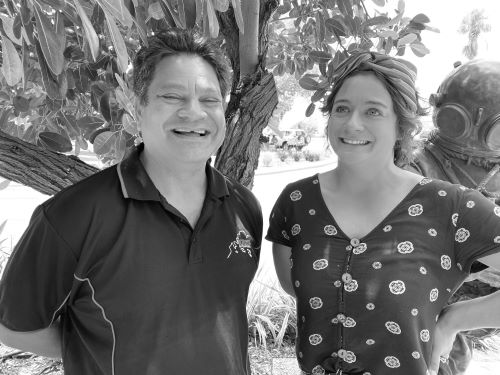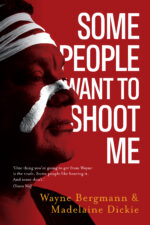Wayne Bergmann and Madelaine Dickie take us behind the scenes of their soon-to-be-released memoir Some People Want to Shoot Me

Wayne Bergmann has spent decades fighting for the rights of Traditional Owners – a job that often puts him in the firing line. So what was it like to reflect back on the entirety of his life – from his childhood to today? To write his story, Wayne called on award-winning novelist and longtime colleague Madelaine Dickie. The result is a unique collaboration and a wonderful new memoir that will entertain and challenge you on every page. Here’s what the authors say about the process of writing Some People Want to Shoot Me.
WAYNE BERGMANN
Why did it feel like the right time to write a memoir?
Working in the Kimberley Land Council was such an all-consuming experience, it felt like a pressure cooker of competing interests. There wasn’t a lot of time to reflect while I was at the fire front. Since stepping back from the Land Council, I have had time to think on my ten years there. Australia and the world saw only a small part of the Land Council story. This memoir was about having the opportunity to tell the untold parts of the story. When I first started at KLC, I began a very steep learning curve of interacting with media and getting a message out to Australians. Sometimes this experience went well and really helped our cause, but often media had their own angle on a story, which was extremely frustrating when only part of a story was being told.
Writing this book provided me with an opportunity to debrief – I hadn’t had a helicopter view of the pressure on us in those years. At the time, all I could do was keep one foot in front of the other and try to survive. Now, looking back, I can see that what Aboriginal people of the Kimberley have achieved in terms of negotiating incredible mining agreements and environmental protections that are some of the best in the world. The world needs to be informed about the benchmark the Kimberley has set and the story of how we achieved that. Often what is portrayed is a skewed story of Aboriginal people being greedy and pillaging their lands for profit. It is time the whole story is told, so other Aboriginal people around the world can also hold mining companies and governments accountable for looking after country and providing opportunities for people to lift themselves out of poverty. The KLC started many years ago with Aboriginal people coming together to stand strong to fight for what was right. Standing together as a group is when the magic happens in the Kimberley – when we come together as a group, we have the power to make things better for everyone. In telling this story I hope I give Australians a new perspective about Aboriginal people: that we are intelligent, we do care about our land and our people, we aren’t lazy or greedy. The recent No Vote shows me that Australians need more information about Aboriginal people. They need the opportunity to hear the good stories, the untold stories – the ones that don’t make the media. I hope this book goes some way to doing that.
Why did you invite Madelaine Dickie to join you as co-author?
I asked Madelaine to co-author this book because I needed someone I could trust. I needed someone who could work with me and my family, who had experienced the highs and lows and challenges of working in this field – the good and the bad. Madelaine had seen the effect of not being able to have our side of a story told properly. I knew Madelaine wouldn’t need a lot of briefing, she already had deep knowledge of the ups and downs of working in this field. Madelaine had worked with me before and I liked how she wrote. She was the best person for this difficult task. And importantly, she knew how to write a good story. When I decided I wanted to get the memoir written I didn’t consider anyone else, Madelaine was my only choice. I approached her and she instantly agreed. I think having her write the story adds appeal to a younger generation of readers as well as to my own. I believe that change happens through this process of informing the next generation.
Madelaine felt passionate that it was an important story to tell, and she agreed with me that to be able to tell it fully, we had to provide the whole context of who I am – and so go back to also tell the stories of my ancestors and the rich history of what happened to them. Madelaine has a gift of writing in such a way that she is able to take facts and history and somehow blend these into an exciting and passionate story. I feel very blessed and grateful she took this challenge on to tell my story.
Did writing this memoir lead you to any revelations you hadn’t realised before?
As I started to tell the stories of the past, I learned many things about my Nyikina ancestors’ lives and about that time in which they lived. As a younger man in Fitzroy, I had worked with all the first contact mob who had walked off the desert in the 1960s – I had a strong notion of how strong and powerful these old people were, to have remained in the desert and survived for so long with no interference from the outside world. They told me many stories of their traditional life in the desert and then their traumatic experiences of first contact.
I didn’t really realise at the time, but I was witnessing an incredible glimpse into what my own family would have had experienced when they had first contact ninety years earlier.
Once you are a leader, is it possible to be anything else? Is it a role you would have chosen for yourself if you had known what it was going to ask of you?
I never put my hand up to be a leader, I think it just evolved as I took on new jobs that required more of me. I have just put one foot in front of each other each day and tried to live and do things to the highest possible standard. I still aspire to be a leader – to be able to say wise things to influence people to do good things. But though I don’t think of myself as a leader, I have certainly felt the pressure of leadership. Once I became a lawyer, all kinds of people came to me for help to sort out their problems. And they are still doing it. Even people who actively opposed me during my time at KLC, or who once criticised me, have come to me for help. What is that about?! I think it is because I have been effective at helping people, and they see me as someone who gets shit done.
What positive changes have you seen in your community in the last couple of decades?
When I was a teenager and a young man, I was just on the edge of those more supportive times, when programs were being pioneered for improving education and supporting Aboriginal kids in school. For me, I was on my own, and I had to make it or break it. I was only the third Aboriginal person to become a lawyer in Western Australia – and the first Aboriginal lawyer to be admitted from the Kimberley.
I have seen some regional towns having a mosaic shift, with Aboriginal people being successful in business and education. A huge positive shift has been Aboriginal native title, which has been determined over almost the whole of the Kimberley. When I first started, this was just an idea.
We now have Aboriginal tradespeople and professionals like doctors, lawyers, teachers, engineers, lots of other professionals. I have seen an increase in our capacity to make change happen. I have seen many more young people finishing school. I have seen a young receptionist who worked for me become a member of parliament. I have seen young field officers at KLC go away to become lawyers. More Aboriginal men and women taking on senior leadership roles and more Aboriginal women on boards of Aboriginal organisations. What I have really noticed is that when Aboriginal people have a job, a steady income and are able to have secure housing, it makes a huge difference to the way they are able to interact in society.
Lately I have noticed little things like airlines acknowledging country, Australia Post having a section on postage bags for the traditional country name, and TV channels acknowledging country. It might not seem like a big deal, but it feels really validating and acknowledging to us.
The other thing that I am proud of in the last few decades is that we have been able to successfully run an Aboriginal economic development foundation (KRED) that has run as a financially successful business without any government funding for the past 12 years.
MADELAINE DICKIE
What did you learn about Wayne that you hadn’t known before?
Working with Wayne on this book allowed me to fully consider the breadth of colonial history in the Kimberley since 1882. In his story I see colonisation by pastoralists superseded by the colonisation of mining companies. I see the way Kimberley Aboriginal people have been browbeaten by over a hundred years of government legislation. I see, woven right through Wayne’s story, that simple, chilling truth from the Uluru Statement from the Heart, that line: These dimensions of our crisis tell plainly the structural nature of our problem. This is the torment of our powerlessness.
I saw an Australia on the eve of a referendum with the power to change this. But – ignorant, indifferent, mean-spirited, racist – we changed nothing.
Considering where we are as a nation, it’s not surprising that when I first announced on social media we’d received funding to work on this book, I was attacked. I was asked why I would waste my talents on a book like this. On a leader like Wayne. On an Aboriginal man. I was floored. Couldn’t believe it. But I got a tiny glimpse into what Wayne endures day in, day out. Simply because he is a change maker. Because he defies the tyranny of low expectations. Because he refuses to accept the status quo. I knew Wayne was resilient but working with him on this story revealed to me to the depths of this resilience.



